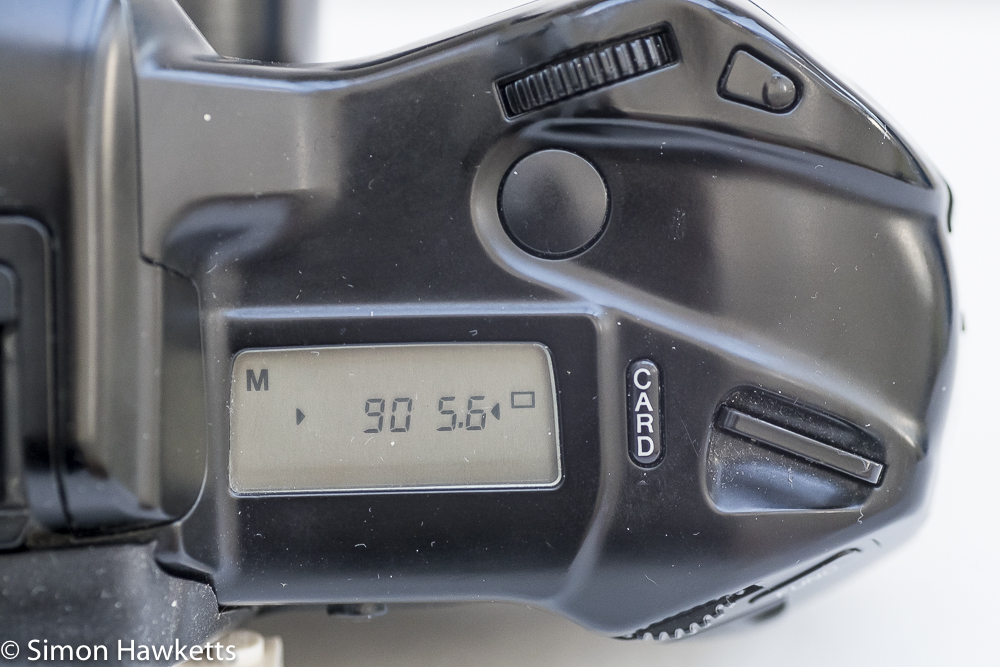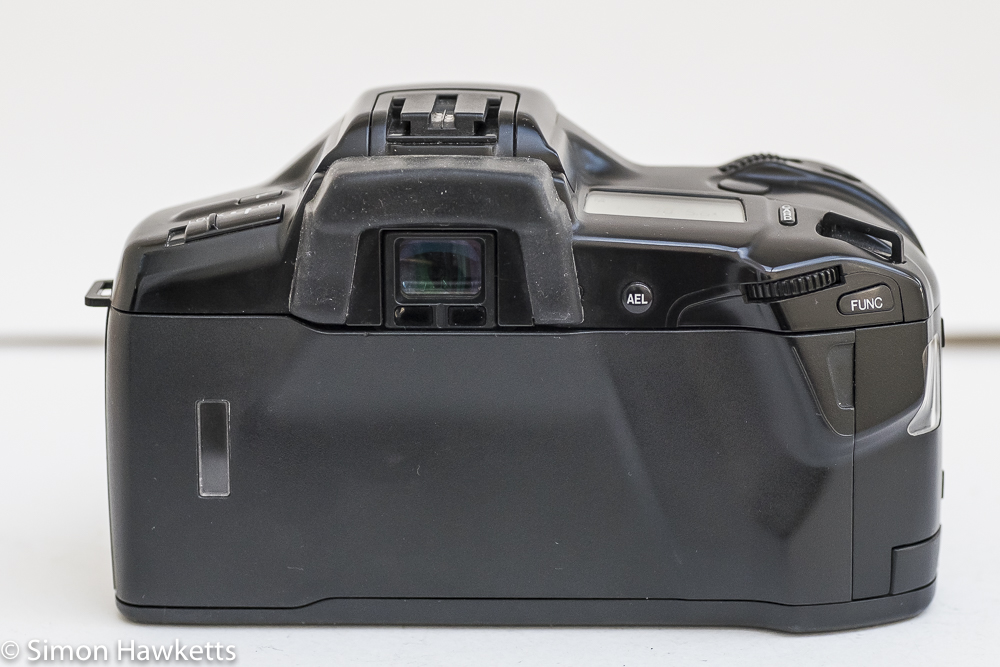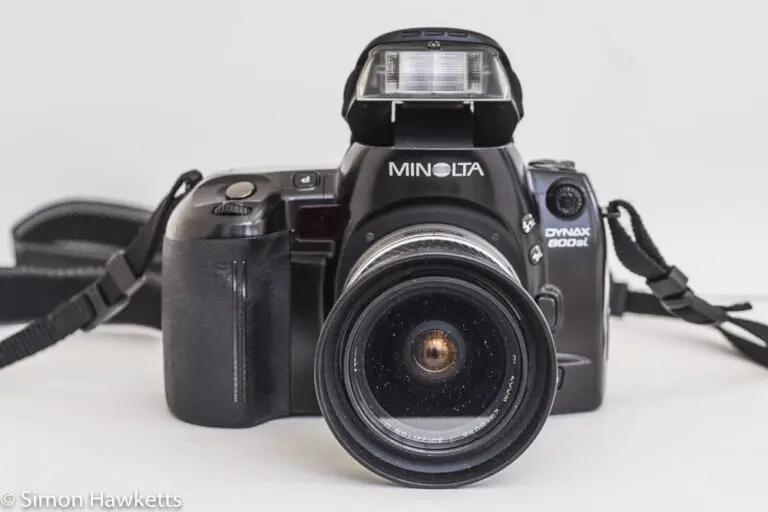Minolta Dynax 7xi 35 mm autofocus SLR
The Minolta Dynax 7xi is a high grade, 35 mm autofocus camera made by Minolta in the early 1990s. At the time, it was the model below the top camera that Minolta made – only the 9xi was above it in the line-up.
Minolta Dynax 7xi Images









My Minolta Dynax 7xi Camera
I bought this camera as part of a job lot of 7 Minolta Dynax film cameras for a total of £25 including postage. For that price, I consider the whole package to be pretty good value for money, even though the cameras came without batteries or lenses.
This camera, the 7xi, was the one which I really had my eye on when I bought the package from eBay, although I subsequently found that one of the other units, a Minolta Dynax 700si is actually a better camera in my opinion. The 7xi is an older model than the 700si and although there isn’t much to choose between them in terms of spec, the 700si wins for handling and ease of use. The 7xi is OK, it is just a bit limited in respect to the number of dedicated, easy access controls available for things like metering mode and drive mode.
The unit itself, in common with all the other cameras in the package, is in almost perfect condition with hardly a mark on the bodywork and all the buttons and controls working properly.
Minolta Dynax 7xi Description
The 7xi is a 35mm autofocus camera made by Minolta in the early 1990s. It is fitted with the Minolta A mount which is the same as the modern Sony digital cameras and is of mostly plastic construction, although by no means does it feel ‘plasticy’.
This is quite a large, heavy camera, which implies it was made for serious photographers who are happy enough to carry such a big load in order to get the photographs they want. The spec also tends to back this up with highlights like a top shutter speed of 1/8000sec, 4 stops of exposure compensation, TTL flash etc, however features like Eye Start (which can’t be switched off on this model) would probably not be welcomed by serious photographers.
And that is the odd thing about the 7xi – it seems a bit confused as to it’s primary purpose. It has a range of features aimed at top end photographers, but without the easy access controls that most experienced photographers would want. It also has a load of features aimed at less experienced photographers, like an ‘everything automatic’ mode button and graphics in the viewfinder to assist with depth of field and freezing action when on shutter or aperture priority.
It seems as if Minolta were trying to hedge their bets and in my opinion probably failed to address either the advanced snapshot market (for which the camera is too big and heavy) or the advanced amateur market (for which the camera doesn’t really have the easy access dedicated controls). However, this is my assessment from 25 years later – I don’t know how successful the 7xi was commercially.
Minolta Dynax 7xi Features
These are some of the stand out features of the camera.
Program Cards and camera controls
Although I don’t think they were a very good idea for the top end cameras like the 7xi, I actually think the addition of the data cards to add extra functionality to their cameras was a novel and interesting idea for Minolta to try out. It was only after I purchased this camera that I looked at the number of individual program cards were available and there were many different cards produced, ranging from some interesting and useful cards offering storage of metadata and multi-spot metering, to more basic functions like program mode or portrait mode.
The cards fitted into a compartment in the side of the camera, and could be enabled with a ‘card’ button on the top panel of the camera. The only card I actually have is an A/S mode card (which adds Aperture Priority and Shutter Priority) which I picked up as part of a Dynax 5000i, but I can’t actually use that card in my 7xi because it doesn’t add any features the camera doesn’t already have.
Inside the cardholder compartment, on the door which swings out, are the controls used to alter drive modes, ISO, flash modes etc. To me, this seems an odd place to put some pretty useful controls like drive mode etc. ISO and film rewind being here is reasonable since you don’t often change the ISO or rewind a roll of film mid-roll, but I would find it difficult to adjust the drive mode with the camera to my eye. Perhaps however I am being a bit unreasonable – although I can see a situation where I would alter the drive mode of a digital camera while I am taking pictures (capturing lots of frames of an action scene) perhaps that situation was less likely to be am option when using film?
Viewfinder information
In common with the 700si, there is an interesting arrangement of information available within the viewfinder. When the camera was manufactured in the early 1990s, it was just starting to be possible to add information into the viewfinder as an image superimposed on the optical display, and Minolta seems to have been one of the early exponents of it.
On this camera, there are several different overlays available. In the centre of the screen is a display of the focus area, which is either a rectangle which the focus points sit within if the camera is in auto point mode, or the individual focus points if one has been selected. If the camera is in spot metering mode, there is a circle at the very centre which shows the metered area.
It’s possible to change the exposure and metering modes with the camera to the eye by pressing a function button by the back control dial. Within the viewfinder display at the top, a little icon displays what the function of the front and back dials is, so they can be adjusted without needing to look at the top display panel.
If the exposure mode is set to aperture or shutter priority, the viewfinder display shows a graphic at the bottom with the effect changing the parameter will have on the picture, for example in aperture priority mode there is a scale with an in-focus scene at one end and a blurred background at the other.
At the bottom of the viewfinder is an LED data panel which displays the set shutter speed, aperture, exposure mode etc.
Exposure, Metering and drive modes
The 7xi is equipped with the exposure modes you would expect for a top class autofocus 35 mm camera, namely Program Mode, Aperture Priority Mode, Shutter Priority mode and fully Manual. In addition, the Program mode settings can be shifted by moving the front control dial to place the camera in P-s mode (effectively shutter priority), or the back dial to place it in P-a mode (effectively Aperture Priority).
The metering options are for patterned metering, when the camera utilizes a 14 segment pattern, or spot metering which limits the sensor to just the central one. 14 segments, although quite limited by today’s standards, is quite high for a camera made in the early 1990s. The metering modes are selected by pressing the func button situated next to the rear control dial and turning the dial. As implied above, the visual feedback for the metering mode you are in is very good.
The auto transport mechanism for the film can do single shot, self-timer and then both fast and slow continuous drive which on my model seemed to be about 3fps and 1fps.
Minolta 7xi general impressions
Overall this is a good camera with a professional spec which is let down a bit by the level of controls available. It can do most things a photographer would want of a film camera but is quite big and heavy and if you wanted a camera with a Minolta A mount lens I would recommend one of the Dynax from the next series like the Dynax 700si every time.
Minolta Dynax 7xi Specifications
- Minolta Dynax 7xi 35mm autofocus camera
- Shutter speeds 30sec to 1/8000 sec
- Exposure modes Manual, Shutter Priority, Aperture Priority, Program mode
- Program shift available with front and back control dials
- Single button press to return to ‘auto’ mode
- 14 segment matrix metering & spot spot-metering
- 4 point autofocus system with focus point selection or auto selection
- Automatic film loading and transport with automatic rewind
- Single shot self timer and multiple shot modes
- Exposure compensation of +/- 4 stops
- TTL flash metering
- AF illumination lamp
- In built flash
- Eye start system which automatically starts autofocus and metering
- DX coded film speed plus override
- ISO 6 to 6000 film speed
- Datacard slot for program enhancement + picture metadata recording
- Serial No: 19109155
- Manual available here
Discover more from Everything Vintage
Subscribe to get the latest posts sent to your email.






Had one of these back in the day, marvellous camera, and yes, heavy! I eventually part exchanged it for a Contax T2, which seemed like a good idea at the time, but didn’t really work out for me.